![]() Click
to
Access
Click
to
Access
OUTSIDE China
![]() Click
to Access
Click
to Access
INSIDE
China ![]()
TRAVEL LINKS
![]() Xiamen
Xiamen
![]() Gulangyu
Gulangyu
![]() Jimei
Jimei
![]() Tong'an
Tong'an
![]() Jinmen
Jinmen
![]() Zhangzhou
Zhangzhou
![]() Quanzhou
Quanzhou
![]() Wuyi
Wuyi
![]() #1Fujian
Sites!
#1Fujian
Sites!
![]() Fujian
Foto Album
Fujian
Foto Album
![]() Books
on Fujian
Books
on Fujian
![]() Readers'Letters
Readers'Letters
![]() Ningde
Ningde
![]() Zhouning
Zhouning
![]() Longyan
Longyan
![]() Sanming
Sanming
![]() Putian
Putian
![]() Bridges
Bridges
![]() Travel
Info,
Travel
Info,
![]() Hakka
Roundhouses
Hakka
Roundhouses
![]() Travel
Agents
Travel
Agents
MISC. LINKS
![]() Amoy
People!
Amoy
People! ![]()
![]() Darwin
Driving
Darwin
Driving ![]()
![]() Amoy
Tigers
Amoy
Tigers
![]() Chinese
Inventions
Chinese
Inventions
![]() Tibet
in 80 Days!
Tibet
in 80 Days!![]()
![]() Dethroned!
Dethroned!
![]()
![]() Misc.Writings
Misc.Writings
![]() Latest
News
Latest
News
![]() Lord
of Opium
Lord
of Opium
![]() Back
to Main Page
Back
to Main Page
![]() Order
Books
Order
Books![]() Xiamenguide
Forum
Xiamenguide
Forum 

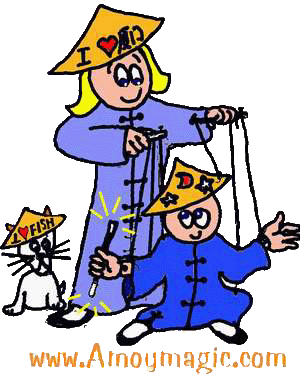
Want to buy Quanzhou Puppets, or arrange
a Marionette Performance? Click
Here to visit the factory!
Or Contact Mr. David Zeng. E-mail: aghzeng@hotmail.com
Mobile: 13799503010 Office:0595-22989432 Fax: 0595-22989431
Click Here for Intro to Quanzhou
Click Here for "City of Springs"
(written by Annie Duncan in 1902)
International Puppet Festivals
Quanzhou was selected to host the International Puppet Festivals in 1986,
1990 and 2000 for one good reason: this ancient center of commerce, philosophy
and religion is also the home of Chinese marionette!
Of course, Quanzhou has many unique crafts, including exquisite paper lanterns, bamboo weaving, porcelain, wood sculpture, tree root carving, paper weaving, lacquer ware, clay sculptures, miniature flour carvings, and 1700 years of Hui’an stone carving, but the icing on the cultural cake is puppets, which stand camphor heads and shoulders above the rest.
The Quanzhou Marionette Troupe
has thrilled audiences in over 30 countries and regions, including performances
in London’s Royal Festival Hall. Over 30 puppeteers manipulate the
puppets while singing to the  background
of a full Chinese orchestra. Unfortunately, it’s hard to catch their
acts at home, but you can arrange a once-in-a-lifetime command performance
for only 2,000 Yuan. Contact the Vice Director of Performers, Mr. Xia
Rong Feng, at 237-5497 Mobile Phone: 13959798518 He can also arrange for
a tour of the marvelous Puppet Troupe’s museum.
background
of a full Chinese orchestra. Unfortunately, it’s hard to catch their
acts at home, but you can arrange a once-in-a-lifetime command performance
for only 2,000 Yuan. Contact the Vice Director of Performers, Mr. Xia
Rong Feng, at 237-5497 Mobile Phone: 13959798518 He can also arrange for
a tour of the marvelous Puppet Troupe’s museum.
Chinese puppetry dates back at least
to the Han Dynasty 2000 years ago, though legend has it the art began
3000 years with King Mu of the Zhou Dynasty. While returning from hunting
in the Kunlun mountains, he saw a carpenter, Yanshi, giving a song and
dance performance with his wooden dolls. The art has changed a lot over
the past two to three thousand years, and has reached its epitome in Quanzhou,
which has the only Chinese puppets that boast their own musical repertoire
performed on unique musical instruments, with over 300 songs and tunes
written for the 700+ traditional puppet shows.
These miraculous marionettes have more strings attached than a henpecked husband. When deftly wielded by a master puppeteer, 14 to 36 strings bring the wooden folk to life as they strut and fret with abandon across intricate Chinese stages.
Unlike Western puppeteers, who work mainly with the control, Chinese puppeteers also manipulate groups of strings with their fingers. The longer the strings (up to 2 meters!), the more difficult to operate, but the more expressive the puppets can become as they portray men and women of all ages and professions—or even spirits or wild animals.
Puppets
make love and war, bicker and barter, dance, jog and somersault. Their
deft hands even retrieve objects from the stage floor! Maybe their lips
move too, because Jimmy sure fell for this fellow (who robs cradles too).
But everything hinges on puppeteers like Mr. Xia Rong Feng, Quanzhou Puppet
Troupe’s Vice Director of Performers (who kindly gave us a tour
and a delightful demonstration).
Puppeteers,
who often begin
training as children, may take 5 years to learn the basics, and over 20
years to completely master the 30+ strings! The sheer complexity of marionettes
is amazing. They have a torso, limbs, strings and a hollow wooden head
(usually camphor or willow) with internal mechanisms to move the lips
and eyes. They have civilian to hold pens and cups or swing fans, and
military hands to brandish swords, spears, and other weapons. There are
even three types of feet: bare, booted, and womanly.
No wonder modern youth aren’t keen on devoting their
lives to mastering puppetry, and the camphor creatures are getting more
complex by the
Modern Puppetry
During the late Qing Dynasty, puppeteers like Lin Chengchi could make
their puppets draw swords and open umbrellas. But today’s generation
of puppeteers are as good, or better. And for all their skill, they are
continuing to perfect their craft to create utterly breathtaking puppets
and performances. Modern stages are deeper, allowing the puppets greater
freedom of movement, and allowing the use of different types of puppets
simultaneously. For example, the Iron-fan Princess in “Flaming Mountain”
is manipulated with strings, poles and fingers.
In “Taming the Monkey,”
the simian puppet monk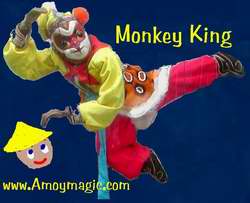 eys
about doing everything from riding a bicycle to playing a guitar. In “Drunken
Zhong Kui,” Kui fails the imperial examination simply because he
is so ugly. After he commits suicide, the King of Hell appoints him “Master
demon chaser,” but he's so overwhelmed by the number of wicked demons
and ghosts that he turns to drink. In the end he goes on the wagon, and
devotes himself to an eternal battle against wickedness. It’s a
hell of a story.
eys
about doing everything from riding a bicycle to playing a guitar. In “Drunken
Zhong Kui,” Kui fails the imperial examination simply because he
is so ugly. After he commits suicide, the King of Hell appoints him “Master
demon chaser,” but he's so overwhelmed by the number of wicked demons
and ghosts that he turns to drink. In the end he goes on the wagon, and
devotes himself to an eternal battle against wickedness. It’s a
hell of a story.
Carrying the Tradition Abroad The
Quanzhou Puppet Troupe gave a short workshop to 11 British puppeteers
and puppet lovers in London's Little Angel Puppet Christopher Leith had
worked with marionettes for over 35 years and still found the training
tough. Still, the Chinese said they’d done well in such a short
time, and should be up to snuff in a couple of years (a long time for
us Westerners, but nothing for Chinese who spend decades at it).

Crafting Puppet Heads Crafting quality
camphor wood puppet heads is a vanishing art. People just aren’t
patient enough nowadayss to spend 10 to 15 years mastering this exacting
craft. Of the few dozen puppet head makers left in Quanzhou, only ten
to twenty make quality puppets. The rest churn out mass produced heads
(or, worse yet, press out plastic heads, which may look the same but don’t
have the soul of the genuine wooden folk).
Puppet heads begin life as a block of camphor wood which is cut to a rough
form, sanded, then carved with finer detail. After a coat of paint, and
then gloss, further details and hair are added. Cheap heads are churned
out in only 3 to 4 days, but it takes Master carver Wang Yique a couple
of weeks to give birth to his masterpieces…
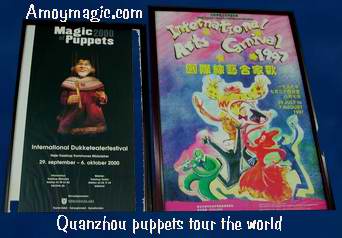 The
article “Heads Up,” in Dragon Air’s in-flight magazine,
“The Silk Road,” (September 1988) was about Quanzhou puppet
master, Wang Yique, who at the time had made puppets for 60 years. Master
Wang said, “I’ve done this since I was 13 years old. I can’t
give it up now. Besides, I want to leave something behind after I’m
gone.” He also noted that none of his children or grandchildren
had chosen to make puppet heads.
The
article “Heads Up,” in Dragon Air’s in-flight magazine,
“The Silk Road,” (September 1988) was about Quanzhou puppet
master, Wang Yique, who at the time had made puppets for 60 years. Master
Wang said, “I’ve done this since I was 13 years old. I can’t
give it up now. Besides, I want to leave something behind after I’m
gone.” He also noted that none of his children or grandchildren
had chosen to make puppet heads.
Wang Yique spends up to half a month carving a head with
exaggerated or distorted features that can be seen from a distance. Some
puppets have four heads, 4 mouths and 8 eyes—all controllable by
one finger! 
Chinese Glove puppets
appear simpler to manage than marionettes, but these too require years
of training. With the forefinger in the head and thumb and middle finger
operating the arms, the puppeteer can perform astonishing feats. The puppets
pour tea into tiny pots, wield fans, change clothes, brandish swords,
or performance somersaults while juggling barrels and dishes on poles
balanced on their head. Quite literally breathtaking. But the real magic
is backstage. Sneak around and take a look. And then take a beautiful
hand puppet home with you. They cost only 80 to 120 Yuan apiece.
Quanzhou Puppet Troupe Museum.
I could spend an entire day going through the endless displays of ancient
and modern puppets ranging from warriors, emperors and the Monkey King
and his entourage, to heroes of the Liberation, foreign villains, and
musician puppets that play violins.
Address: No. 24 Tongzheng Lane, Quanzhou.

Boxer Rebellion? Our old friend Dave Hollinger (well, he's not that old--or at least not as old as he looks) was delighted with the boxing hand puppets sold on Gulangyu Island! I even bought a pair myself (at 50 cents each, why not?). As I played with them, one Chinese asked which would win, Bush or Saddam. But I refused to answer, lest I get "caught between Iraq and a hard place." (though the president did look a bit Bius
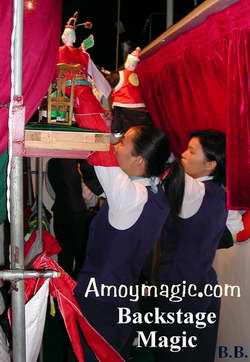
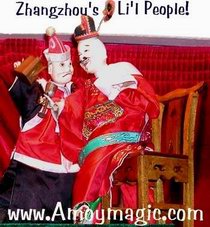
![]() Favorite
Fujian Sites
Favorite
Fujian Sites ![]() Fujian
Foto Album
Fujian
Foto Album ![]() Xiamen
Xiamen
![]() Gulangyu
Gulangyu
![]() Fujian
Guides
Fujian
Guides ![]() Quanzhou
Quanzhou
![]() Zhangzhou
Zhangzhou
![]() Longyan
Longyan
![]() Wuyi
Mtn
Wuyi
Mtn ![]() Ningde
Ningde
![]() Putian
Putian
![]() Sanming
Sanming
![]() Zhouning
Zhouning
![]() Taimu
Mtn.
Taimu
Mtn. ![]() Roundhouses
Roundhouses
![]() Bridges
Bridges
![]() Jiangxi
Jiangxi
![]() Guilin
Guilin
![]() Order
Books
Order
Books
![]() Readers'
Letters
Readers'
Letters
Last Updated: May 2007
![]()
DAILY
LINKS
![]() FAQs
Questions?
FAQs
Questions?
![]() Real
Estate
Real
Estate
![]() Shopping
Shopping
![]() Maps
Maps
![]() Bookstores
Bookstores
![]() Trains
Trains
![]() Busses
Busses
![]() Car
Rental
Car
Rental
![]() Hotels
Hotels
![]() News
(CT)
News
(CT)
![]() Medical
& Dental
Medical
& Dental
![]() YMCA
Volunteer!
YMCA
Volunteer! ![]()
![]() XICF
Fellowship
XICF
Fellowship
![]() Churches
Churches
![]()
![]()
![]() Temples
Temples![]()
![]() Mosque
Mosque
![]() Expat
Groups
Expat
Groups
![]() Maids
Maids
![]() Phone
#s
Phone
#s
EDUCATION
![]() Xiamen
University
Xiamen
University
![]() XIS(Int'l
School)
XIS(Int'l
School)
![]() Study
Mandarin
Study
Mandarin
![]() CSP(China
Studies)
CSP(China
Studies)
![]() Library
Library
![]() Museums
Museums
![]() History
History
DINING
![]() Restaurants
Restaurants
![]() Asian
Asian
![]() Veggie
Veggie
![]() Junk
Food
Junk
Food
![]() Chinese
Chinese
![]() Italian
Italian
![]() International
International![]()
![]() Visas
4 aliens
Visas
4 aliens
RECREATION
![]() Massage!
Massage!
![]() Beaches
Beaches
![]() Fly
Kites
Fly
Kites
![]() Sports
Sports
![]() Boardwalk
Boardwalk
![]() Parks
Parks
![]() Pets
Pets
![]() Birdwatching
Birdwatching
![]() Kung
Fu
Kung
Fu ![]() Hiking
Hiking
![]() Music
Events
Music
Events
![]() Festival&Culture
Festival&Culture
![]() Humor&
Humor&![]() Fun
Fotos
Fun
Fotos![]()
BUSINESS
![]() Doing
Business
Doing
Business
![]() Jobs!(teach/work)
Jobs!(teach/work)
![]() Hire
Workers
Hire
Workers
![]() Foreign
Companies
Foreign
Companies
![]() CIFIT
(Trade Fair)
CIFIT
(Trade Fair)
![]() MTS(Translation)
MTS(Translation)
![]()
Back to Top





